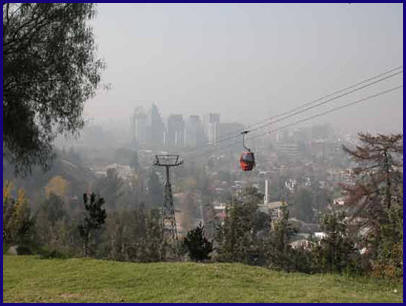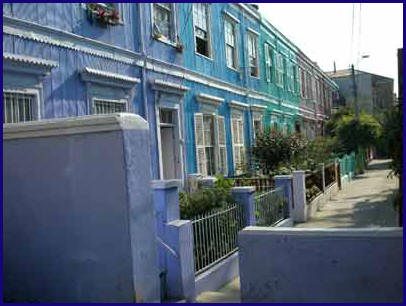
|
When we left Buenos Aires for the final time in May our first stop was Santiago de Chile. We stayed in a small private hotel/guest house called Vilafranca. This is exactly the type of hotel one always dreams of finding, but rarely does. More like staying at the home of a friend of a friend. Someone you don't know all that well, but who is doing their utmost to make you feel comfortable in their home and your stay a pleasant one. Vilafranca is that hotel and Gloria is that hostess. Santiago doesn't have the elegance of Buenos Aires though it does also have great wine and good food, but not as cheap. Nor does it have the Inca ruins that have made neighbouring Peru such a tourist destination. It does have the Andes, they dominate the city and it's impossible not to be aware of them. It also has horrible pollution. And this also is in partly due to the Andes. Santiago nestles in a bowl in the foothills which allows very limited air change with the result that the city is generally covered in a haze of smog. |
|
 |
The other thing that characterises Santiago is energy. It's hard exactly to define, but there's something (other than the smog) in the air. This feeling is compounded by the immense amount of building work going on. Several years of a South American stable government seems to have made Santiago the place to build your new headquarters if you are a bank or multinational. And with them comes the hotels. Maybe it's more than the mountains that make this feel like a South American Switzerland. The people are friendly and it feels safe to walk the streets, always a plus for those without transport. If you happen to be looking in the one direction that doesn't have the Andes themselves in the background then you'll discover another smaller mountain sprouting right out of the centre of town, the Cerro de San Cristobel. Since it's too steep to easily build on, the Chileans have pragmatically converted it into a national park which has been done with thought and consideration, with places to sit and marvel at the view or just read the local rag and have a nap. A longish walk or 2 cable cars will take you to the top, where on a rare smog free day you would have a stunning view across the city. We though had to settle for a fine view of the smog. |
|
There are two other things really worth visiting if you ever make it to Santiago. The first is the fish market. Built as everyone will stop to tell you of British wrought iron. The centre of the market is now populated by a few upmarket and slightly touristy restaurants. But this is still a working fish market and around the perimeter of the building are smaller restaurants who will cook and serve you anything fishy that can be had from a stall in the market. And the Museo de Arte Precolumbiana. It didn't sound all that interesting. Chile was on the edge of the Inca empire and didn't have any of the great sites that exist further north and we were heading to Peru anyway. So we have to thank two American tourists we met briefly at Iguazu who recommended it to us or we would probably have missed it. It has remarkable collections, ceramics, metal, textiles, but the star of the show is without a doubt the mummies. These predate the earliest Egyptian examples by thousands of years. Unlike the Egyptians the people who produced them were nomadic hunter gatherers who carried the mummies with them as they travelled. Often a number of individual bones have been replaced by the same bones from family members of a later generation. Nobody knows if this was because bones had been lost and needed replacement, or whether in some ways the mummies represented a collective family spirit. Whichever is true they remain remarkable. |
|
And then, we cannot leave Chile without mentioning Valparaiso. The valley of paradise. It's a name that conjures romance and excitement. It's a place where writers, poets and artists went to be inspired. It's a World Heritage Site. It's a truly truly horrible city totally without any endearing feature. Valparaiso's wealth came from the port which was a stopping point for ships rounding the Horn. That all stopped when the Panama Canal opened and it has been downhill ever since. Now it is a dilapidated, down-at-heel, ex-major port and there are plenty of them around the world. The historic centre which forms the world heritage site is where the wealthy of Valparaiso once lived. Sited on one of the city's hills, served by a few decrepit funicular railways, it's a collection of corrugated iron town houses, a couple of short streets have been repainted, but mostly not. The picture to the right looks OK but really it's the very best there is. If enough UN money is poured in then maybe the area could be restored so as to be interesting and attractive, but it can never be more than a handful of short streets and it will still be in the middle of Valparaiso. If you ever do decide to visit and find Valparaiso has developed into a wonderful place, drop us a line and let us know - but you have been warned!
|
 |